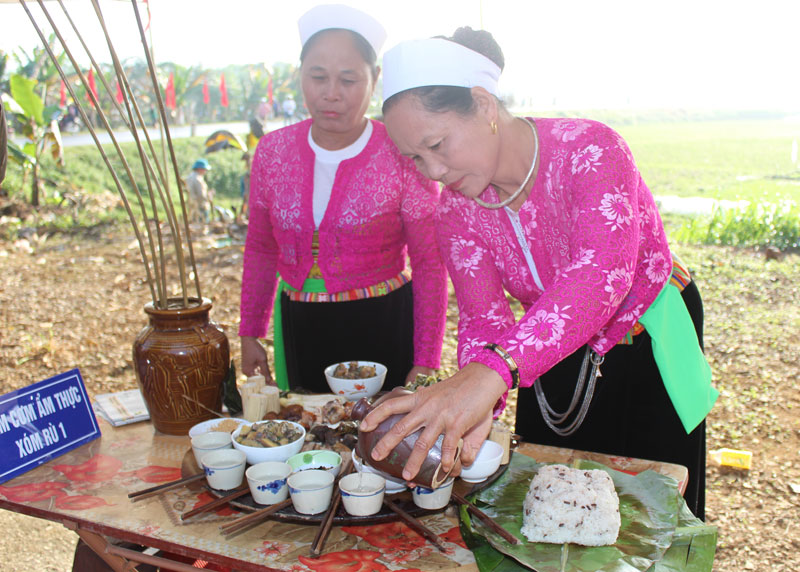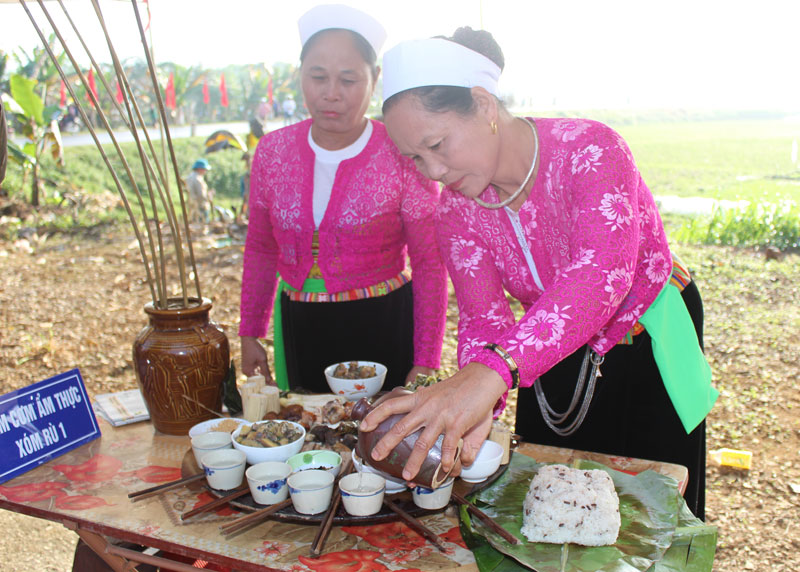
(HBO) – Despite changes in their modern life, an increasing number of Muong ethnic women seek their ways back to their old days by wearing traditional dresses to celebrate lunar New Year (Tet) instead of modern outfits.

Muong Dong ethnic women in
Kim Boi district in traditional costumes prepare a tray of their signature
dishes.
In an interview with
reporters from the Hoa Binh Newspaper, Bui Thi Hao from Chanh hamlet in Vinh
Dong commune said with delight that in her village, elderlies wear Muong costumes
every day while younger women prefer Muong dresses for the occasions of
festivals, ceremonies, and weddings.
According to her, all
women in her village own at least one traditional dress and a silver chain belt,
passed down as a special keepsake among women in their families for
generations.
A traditional Muong dress
consists of a white shirt and long black skirt. The outfit, which is suitable
for different body sizes, keeps its wearer comfortable in the cool weather in spring
but is still elegant enough. Nowadays, the shirt has more colours than just
white due to local women’s preferences.
Life is changing. Muong
people’s stilt houses have been replaced with cement ones, and parts of their
language and traditions modified. However, their costume embodies a strong
power to survive and even thrive in the modern life./.
With an increasingly vibrant and widespread emulation movement aimed at building cultured residential areas and cultured families, Yen Thuy District has been making steady progress toward improving both the material and spiritual well-being of its people, while fostering a civilized, prosperous, beautiful, and progressive community.
Once lacking recreational spaces and community facilities, Residential Group 2 in Quynh Lam Ward (Hoa Binh City) has recently received attention for the construction of a new, spacious, and fully equipped cultural house. The project followed the model of state support combined with public contributions in both labor and funding.
The "All people unite to build cultural life" movement, which has been effectively integrated with Kim Boi district’s socio-economic development goals, is fostering a lively spirit of emulation across local residential areas, hamlets, villages, public agencies, and enterprises. In addition, through the initiative, traditional cultural values are being preserved and promoted, while community solidarity and mutual support in poverty reduction and economic development are being strengthened.
A working delegation of the Hoa Binh provincial People’s Committee led by its Permanent Vice Chairman Nguyen Van Toan on June 11 inspected the progress of a project to build the Mo Muong Cultural Heritage Conservation Space linked to tourism services in Hop Phong commune, Cao Phong district.
Born and growing in the heroic land of Muong Dong, Dinh Thi Kieu Dung, a resident in Bo town of Kim Boi district, in her childhood was nurtured by the sweet lullabies of her grandmother and mother. These melodies deeply imprinted on her soul, becoming an inseparable part of her love for her ethnic group's culture. For over 20 years, this love for her hometown has driven Dung to research, collect, and pass down the cultural values of the Muong people to future generations.
In the final days of May, the Ethnic Art Troupe of Hoa Binh Province organized performances to serve the people in remote, mountainous, and particularly disadvantaged areas within the province. These were not just ordinary artistic shows, but they were the meaningful journeys aimed at spreading cultural values, enhancing the spiritual life of the people and contributing to the preservation of ethnic minority cultural identities.



